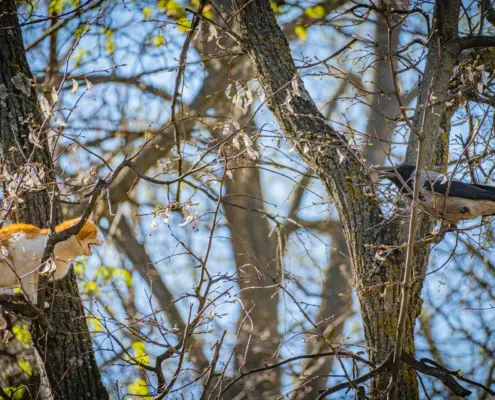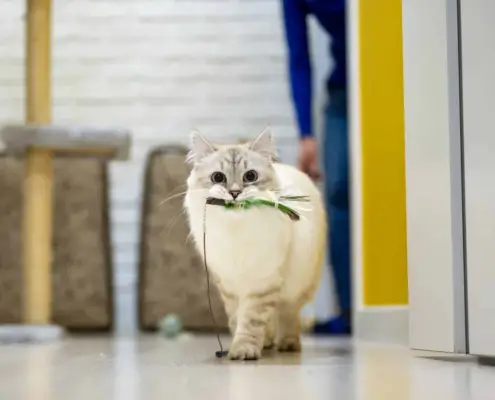
Cats have been living alongside humans for thousands of years, but their domestication process differs from that of dogs. Unlike dogs, cats were not specifically bred for certain traits or purposes. Instead, they chose to form a bond with humans on their own terms. The evolution of cats’ relationship with humans can be traced back to ancient civilizations, where cats were highly regarded for their hunting skills and ability to keep pests at bay.
Over time, cats started to seek out human companionship not just for their own survival, but also for the comfort and security that humans provided. This mutualistic relationship allowed cats to thrive in human settlements, where they were provided with food, shelter, and protection. In return, cats offered their skills as hunters and companionship to their human counterparts.
Understanding Cats’ Social Behavior
To understand why cats choose to be friendly with humans, it is important to delve into their social behavior. Cats are naturally solitary animals, and their social structure is based on resource availability and individual territory. However, contrary to popular belief, cats are not completely independent and aloof creatures. They are capable of forming social bonds, both with other cats and with humans.
Cats have a complex communication system that involves vocalizations, body language, and scent marking. They use these cues to establish territory, communicate with other cats, and interact with humans. Understanding these communication cues is crucial in deciphering a cat’s friendliness towards humans. For example, a cat that approaches a human with a relaxed body posture, purring, and rubbing against their legs is displaying signs of friendliness and seeking social interaction.
The Benefits of Cats Being Friendly with Humans
The friendly nature of cats towards humans has numerous benefits for both parties involved. For humans, the companionship and affection provided by a friendly cat can have positive effects on mental and emotional well-being. Interacting with a cat has been shown to reduce stress, lower blood pressure, and promote relaxation. Cats can also provide a sense of purpose and responsibility, making them excellent therapy animals for individuals with certain medical conditions or disabilities.
On the other hand, cats also benefit from being friendly with humans. Domestic cats rely on humans for their basic needs, such as food, water, and shelter. By forming a bond with humans, cats ensure a stable source of resources and protection. Friendly cats are more likely to receive regular veterinary care, which is essential for their health and longevity. Additionally, cats that are friendly towards humans are more likely to be adopted and find loving homes, improving their overall quality of life.
Factors That Influence a Cat’s Friendliness towards Humans
Not all cats are equally friendly towards humans, and several factors can influence their level of friendliness. One important factor is early socialization. Kittens that are exposed to positive human interactions during their early development stages are more likely to grow up to be friendly and social cats. This highlights the importance of early socialization in shaping a cat’s behavior towards humans.
Another factor that influences a cat’s friendliness is their individual personality. Just like humans, cats have unique personalities that can range from outgoing and friendly to shy and reserved. Genetic factors, such as breed and lineage, can also play a role in a cat’s friendliness towards humans. However, it is important to note that an individual cat’s past experiences and environment also significantly impact their behavior towards humans.
The Role of Early Socialization in Cat-Human Relationships
Early socialization plays a crucial role in forming strong and positive cat-human relationships. It is important to expose kittens to various positive experiences with humans during their early weeks of life. This can include gentle handling, play sessions, and positive reinforcement. By doing so, kittens learn to associate humans with positive experiences, which sets the foundation for a friendly and trusting relationship.
If a cat has not been adequately socialized during their early stages of life, it may take more time and patience to build trust and establish a bond. However, with consistent positive interactions and gradual exposure to new experiences, even older cats can learn to be friendly and trusting towards humans. It is important to respect a cat’s boundaries and give them space when needed, allowing them to gradually build confidence and trust in their own time.
Communication Cues That Indicate a Cat’s Friendliness
Understanding a cat’s communication cues is essential in determining their friendliness towards humans. Cats use a combination of vocalizations, body language, and scent marking to convey their feelings and intentions. For example, a friendly cat may exhibit behaviors such as purring, rubbing against their human’s legs, and engaging in gentle play. These behaviors indicate a desire for social interaction and an overall positive attitude towards humans.
On the other hand, aggressive or fearful behaviors, such as hissing, growling, and defensive postures, indicate that a cat is not comfortable or friendly towards humans. It is important to respect these cues and give the cat space to feel safe and secure. Pushing a cat to interact when they are displaying signs of fear or aggression can lead to further stress and damage the potential for a positive relationship.
The Impact of Positive Interactions on a Cat’s Behavior
Positive interactions with humans can have a profound impact on a cat’s behavior and overall friendliness. By providing a cat with love, attention, and positive reinforcement, humans can reinforce desirable behaviors and strengthen the bond between themselves and their feline companions. Regular play sessions, grooming, and providing a stimulating environment can also help to keep a cat’s mind and body active, contributing to their overall well-being and friendliness.
It is important to note that building a strong bond with a cat takes time and patience. Each cat is different and may require different approaches to feel comfortable and trusting. By consistently providing positive experiences, respecting their boundaries, and being attentive to their needs, humans can nurture a strong and loving bond with their feline companions.
Misconceptions about Cats’ Friendliness towards Humans
There are several misconceptions surrounding cats’ friendliness towards humans. One common misconception is that all cats are aloof and independent, and only seek human interaction when they want something, such as food. While it is true that cats value their independence, many cats are genuinely affectionate and seek out human companionship on their own terms.
Another misconception is that cats are not capable of forming deep emotional bonds with their human caretakers. However, numerous studies have shown that cats are indeed capable of forming strong emotional attachments to their human companions. Cats can show love, loyalty, and a deep sense of attachment, just like dogs or other pets.
Conclusion
Cats’ friendliness towards humans is a result of their complex evolutionary history and their ability to form social bonds. Understanding cats’ social behavior, early socialization, and communication cues is essential in fostering positive relationships with these feline companions. By providing love, attention, and positive experiences, humans can build strong bonds with friendly cats, benefiting both parties involved. It is important to dispel misconceptions about cats’ friendliness and appreciate their unique personalities and capacity for emotional connection. So, the next time a friendly cat seeks out your company, embrace the feline connection and cherish the bond that forms.
If you enjoyed my article, I would appreciate you sharing it with your network.

Sima Ndlebe
Sima writes for CatBuzz. He is interested in Cats, Health and Fitness, and Entrepreneurship.
Published: 13 November 2023



